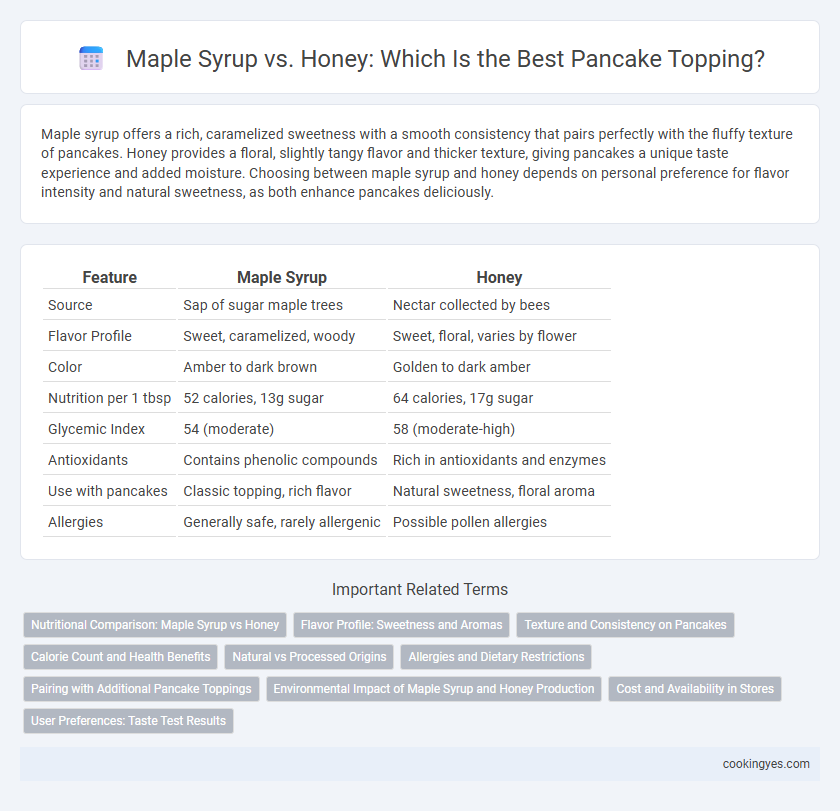Maple syrup offers a rich, caramelized sweetness with a smooth consistency that pairs perfectly with the fluffy texture of pancakes. Honey provides a floral, slightly tangy flavor and thicker texture, giving pancakes a unique taste experience and added moisture. Choosing between maple syrup and honey depends on personal preference for flavor intensity and natural sweetness, as both enhance pancakes deliciously.
Table of Comparison
| Feature | Maple Syrup | Honey |
|---|---|---|
| Source | Sap of sugar maple trees | Nectar collected by bees |
| Flavor Profile | Sweet, caramelized, woody | Sweet, floral, varies by flower |
| Color | Amber to dark brown | Golden to dark amber |
| Nutrition per 1 tbsp | 52 calories, 13g sugar | 64 calories, 17g sugar |
| Glycemic Index | 54 (moderate) | 58 (moderate-high) |
| Antioxidants | Contains phenolic compounds | Rich in antioxidants and enzymes |
| Use with pancakes | Classic topping, rich flavor | Natural sweetness, floral aroma |
| Allergies | Generally safe, rarely allergenic | Possible pollen allergies |
Nutritional Comparison: Maple Syrup vs Honey
Maple syrup contains antioxidants and minerals like manganese and zinc, providing a richer nutrient profile compared to honey, which is higher in vitamins such as vitamin C and has antimicrobial properties. Honey has a higher calorie content and a lower glycemic index, making it a slightly better option for blood sugar control. Both maple syrup and honey offer natural sweetness, but maple syrup has fewer sugars per serving and delivers essential minerals beneficial for overall health.
Flavor Profile: Sweetness and Aromas
Maple syrup offers a rich, caramel-like sweetness with smoky undertones that enhance the natural flavor of pancakes, while honey provides a floral, fruity sweetness with subtle earthy notes. The complexity of maple syrup's aroma tends to complement both plain and buttered pancakes, creating a warm, inviting taste experience. Honey's aromatic profile varies by type, from mild clover to robust buckwheat, adding a distinct, nuanced sweetness that pairs well with fruit-topped or nutty pancakes.
Texture and Consistency on Pancakes
Maple syrup offers a smooth, liquid texture that evenly soaks into pancakes, enhancing their moistness without overwhelming the batter's fluffiness. Honey provides a thicker, stickier consistency that clings to the pancake surface, delivering a rich and slightly chewy bite. Both toppings complement pancakes differently, with maple syrup creating a gentle glaze and honey adding a dense, textured layer.
Calorie Count and Health Benefits
Maple syrup contains about 52 calories per tablespoon and provides antioxidants and minerals like manganese and zinc, supporting immune health. Honey has approximately 64 calories per tablespoon and offers antibacterial properties along with traces of vitamins and minerals. Choosing between the two depends on calorie considerations and specific health benefits, with maple syrup being slightly lower in calories and honey known for its antimicrobial effects.
Natural vs Processed Origins
Maple syrup, derived from the sap of sugar maple trees, offers a natural and minimally processed topping rich in antioxidants and minerals. Honey, produced by bees from flower nectar, is also a natural sweetener but often undergoes filtration and pasteurization, impacting its raw qualities. Choosing between these toppings depends on preference for pure tree sap sweetness versus floral nectar complexity, with both providing unique natural origins compared to highly processed syrups.
Allergies and Dietary Restrictions
Maple syrup serves as a natural, gluten-free option for pancake topping, suitable for those with common allergies, while honey, though also natural, may trigger allergic reactions in individuals sensitive to pollen or bee products. Vegans typically prefer maple syrup, as honey is an animal-derived product and excluded from vegan diets. Both options offer distinct nutritional profiles; maple syrup contains some antioxidants and minerals, whereas honey provides antibacterial benefits but varies in glycemic index.
Pairing with Additional Pancake Toppings
Maple syrup's rich, caramelized flavor pairs exceptionally well with classic pancake toppings like butter, fresh berries, and nuts, enhancing their natural sweetness and texture. Honey offers a floral sweetness that complements toppings such as yogurt, cinnamon, and sliced almonds, creating a lighter, more nuanced taste experience. Both toppings can be combined with savory options like bacon or cheddar to balance sweetness and add complexity to the pancake stack.
Environmental Impact of Maple Syrup and Honey Production
Maple syrup production involves tapping sugar maple trees and boiling sap, which is generally considered sustainable as it supports forest conservation and carbon sequestration. Honey production requires beekeeping, which plays a crucial role in pollination and biodiversity but faces challenges from colony collapse disorder and pesticide exposure. Both industries have environmental impacts, but maple syrup's carbon footprint tends to be lower due to minimal processing compared to honey's reliance on maintaining healthy bee populations.
Cost and Availability in Stores
Maple syrup typically costs more than honey, with prices averaging around $20 per quart compared to honey's $6 to $12 per quart, reflecting its labor-intensive production process. Both toppings are widely available in grocery stores, but honey is often found in larger variety and sizes, including organic and specialty types, making it more accessible to budget-conscious shoppers. Consumers seeking cost-effective and easily obtainable pancake toppings may prefer honey, while those prioritizing traditional flavor might opt for the pricier but distinct maple syrup.
User Preferences: Taste Test Results
Taste test results reveal a nearly even split in user preferences between maple syrup and honey as pancake toppings, with 52% favoring maple syrup for its rich, caramel-like flavor and 48% choosing honey for its natural sweetness and floral undertones. Participants citing maple syrup highlighted its traditional association with pancakes and slightly thicker consistency, enhancing texture, while honey fans appreciated its health benefits and unique aromatic profile. These findings underscore varied taste preferences influencing pancake topping choices, reflecting individual palates and dietary considerations.
Maple Syrup vs Honey for Pancake Topping Infographic

 cookingyes.com
cookingyes.com